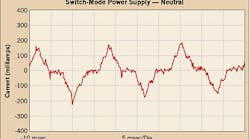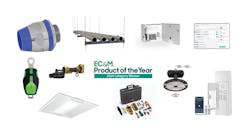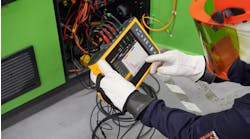Historically, typical loads of commercial power systems have been predominately linear; however, in the last few decades, a significant portion of these loads has changed to the nonlinear variety. One invention that's used as a major component of phase-to-neutral nonlinear loads is the switch-mode power supply, used in a wide range of personal electronic devices (probably the most prominent of which is the personal computer or PC). The following case study reveals how a large population of PCs led to overheated distribution transformers and neutral conductors at a commercial facility.
The particulars
The building's power distribution system had a 1,600A capacity and included a 500kVA in-line UPS system. The output of the UPS system fed three 150kVA dry-type transformers, which, in turn, fed a series of 42-breaker, 3-phase distribution panels. These panels provided power for branch circuits feeding approximately 1,200 switch-mode power supplies.
Figure 1 shows the graph of the neutral current waveform of a typical switch-mode power supply used in this case study. Note that the individual supply draws approximately 0.4A on a single-phase circuit. Figure 2 depicts the corresponding harmonic spectrum of this switch-mode power supply. Note that a 3rd harmonic content of 40% and a total harmonic distortion (THD) of 51% are present.
Figure 3 shows the current on each of the phases of a typical 42-breaker distribution panel in the system. As you can see, all three of the phases were very rich in harmonics. The peak-to-peak current was 16A for Phase A, 19A for Phase B, and 22A for Phase C. The distribution panel supplied power to approximately 120 switch-mode power supplies, which corresponds to approximately 40 switch-mode power supplies per phase.
Figure 4 shows the corresponding harmonic spectrums. As is typical with switch-mode power supplies, the phase currents had an extremely high content of the third harmonic as well as an extremely high THD value. Phase A had a 3rd harmonic content of 40%, Phase B of 53%, and Phase C of 60%. The next zero sequence or triplen harmonic, the 9th, was less than 5% for all of the phase currents.
The extremely high harmonic content on the phase currents created a serious issue with the common neutral conductor of a distribution panel feeder. Ideally on a 3-phase system with balanced loads, the neutral current at the distribution panel feed would be approximately zero. However, when the phase currents have high triplen harmonic content, the neutral conductor is forced to carry the current caused from the distortion in the phase conductors.
Figure 5 shows the graph of the current waveform of the neutral conductor for the distribution panel. As you can see, it was less distorted but had higher current than the corresponding phase waveforms. In fact, the current on the neutral conductor was higher than the current on any of the phase conductors. Figure 6 depicts the harmonic spectrum of the neutral conductor, indicating a 3rd harmonic content of 100% and a fundamental content of 17%.
Modifications to handle harmonic distortion
After diagnosing the problems, it was time to make design changes to the system. The first step was to provide an additional transformer and distribution board to provide an even number of transformers and distribution boards. The original system had three transformers and distribution boards. The even number of distribution boards is needed for the harmonic canceling transformers to efficiently cancel the harmonic content between distribution boards.
The next step was to ensure the four distribution boards were evenly balanced with the same load on each board. This was basically a straightforward balancing process to have the same number of distribution panels fed from each distribution board. Then came the replacement of the existing transformers with new harmonic canceling transformers. The winding configuration of these transformers allowed the triplen harmonic currents generated by the switch-mode power supplies to be trapped and canceled prior to reaching the UPS system. There were a few transformer types reviewed prior to selecting the one used; however, all of the types reviewed used the same basic harmonic mitigation concept.
The neutral conductors to each distribution panel and each panel feeder were doubled in size, which would ensure that these conductors would have enough circular mil area to handle additional expansion if needed and reduce possible overheating conditions in the conductors (see Overloaded Neutral Conductor: General Solutions on page 40). The final step to deal with the harmonic issue was to replace the existing UPS system, which was done for several reasons. The newer UPS system provided a better system design and a better method to reduce the THD of the entire system. Also, the original UPS system was 10 years old and manufactured prior to the surfacing of the issue of harmonic distortion in power systems.
Key concepts
What can we learn from this case? The harmonic distortion caused by switch-mode power supplies can become an extremely important issue on a 3-phase, 4-wire system. You should not limit your concern of harmonic distortion in a power system to the triplen harmonics, which are generated by phase-to-neutral nonlinear loads, as phase-to-phase nonlinear loads also generate harmonic currents. But regarding the neutral conductor, the zero sequence harmonics should be your primary concern. This issue can be attributed to several factors.
The first factor is that the current magnitudes of the triplen harmonics in a 3-phase power system add together on the neutral conductor, resulting in a current that is higher than the current on any of the phase conductors. In fact, this current can be as high as 1.7 times the current on a corresponding phase conductor. The next factor is the 30° phase shift between the primary and secondary windings of a transformer.
The NEC considers transformers separately derived sources and, as such, the neutral conductor is grounded. A delta winding in a transformer does not allow the triplen harmonics to leave the winding, causing them to be “trapped” in this winding and keeping them from migrating further upstream within the system. Because the triplen harmonics are trapped in the delta winding, the only way the energy from the triplens can escape is through heat.
Pay is a principal with Finnegan Erickson Associates, Henderson, Nev. He can be reached at [email protected].
Sidebar: Overloaded Neutral Conductor: General Solutions
In general, there are several options or precautions to avoid overloading the neutral conductor. Some include: oversizing the common neutral conductor, providing one neutral conductor per phase, harmonic filtering, harmonic canceling transformers, and using manufactured power supplies that produce less than 5% THD.
The first step to correct the overloading of the neutral conductor should be to verify that the nonlinear loads are balanced on all three phases. This will mitigate the positive and negative sequence harmonics, leaving only the zero sequence or triplen harmonics on the neutral conductor. The balancing will enable the other methods to be more effective in mitigating the overloading condition.
A common method used to compensate for the triplen harmonic currents on the neutral conductor is to oversize the common neutral conductor. A typical method is to use a conductor twice the circular mil area of the phase conductors. Although this method will eliminate the overloading condition on a balanced 3-phase system, it may not be cost effective for systems that are not made up of 100% electronic loads.



